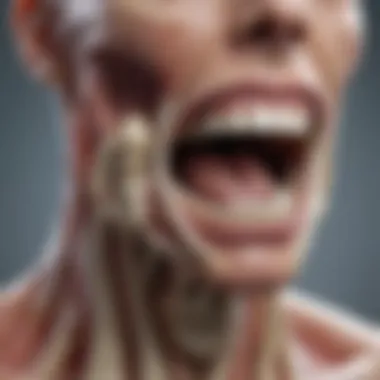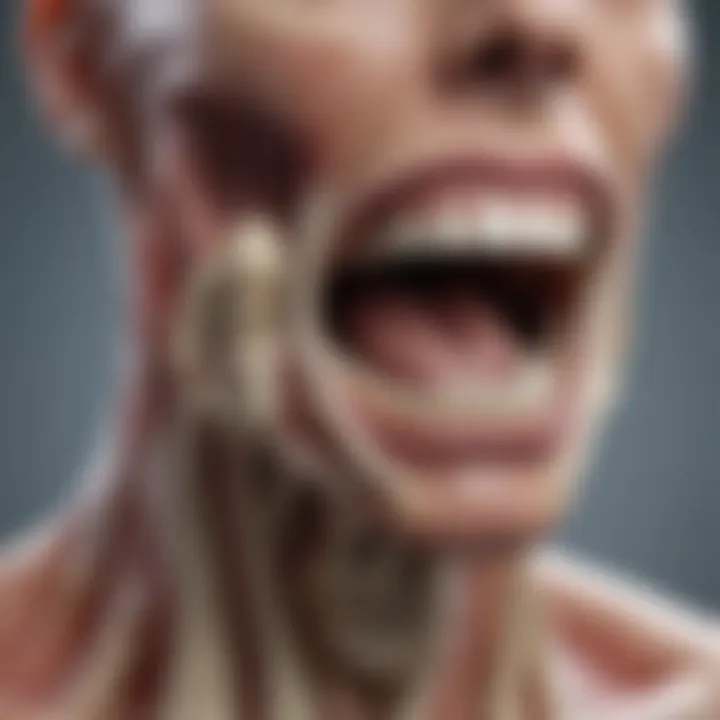TMJ Diagnostic Criteria: A Comprehensive Examination


Intro
Temporomandibular joint (TMJ) disorders encompass a range of conditions related to the jaw, jaw joint, and surrounding muscles. They can lead to significant discomfort, including pain, limited jaw movement, and other functional complications. Understanding the diagnostic criteria for TMJ disorders is essential for both healthcare providers and patients. A precise diagnosis can guide effective treatment strategies, enhance patient outcomes, and create awareness about this often-misunderstood condition.
Research Overview
Summary of Key Findings
Research into TMJ disorders reveals several critical insights regarding their etiology and symptom presentation. Various studies indicate a strong link between psychological factors, such as stress and anxiety, and TMJ dysfunction. Additionally, the prevalence of TMJ disorders appears to be notably higher among individuals who grind their teeth or exhibit jaw clenching behaviors. Comprehensive assessments focus on both clinical symptoms and the psychological well-being of the patient.
The current consensus emphasizes a multidisciplinary approach to diagnosing TMJ disorders, integrating input from dental professionals, physical therapists, and mental health experts.
Importance of the Research
The exploration of TMJ diagnostic criteria holds significance for multiple reasons. First, it clarifies the confusion surrounding TMJ disorders, which are often mistaken for other conditions like sinus issues or ear infections. Second, it promotes a structured methodology for clinicians in assessing and diagnosing patients with TMJ symptoms. This, in turn, fosters a better understanding that informs both practitioners and patients alike. It also highlights the need for education about preventive measures and lifestyle changes, which can alleviate symptoms in affected individuals.
Methodology
Study Design
Research regarding TMJ disorders commonly employs a mixed-method study design. This involves quantitative measures, such as surveys assessing symptom severity and quality of life, combined with qualitative interviews exploring patient experiences. By integrating these approaches, researchers can develop a comprehensive understanding of the disorder’s impact.
Data Collection Techniques
Data collection for studies on TMJ disorders may include:
- Surveys distributed to patients experiencing TMJ symptoms. These surveys often assess pain levels, frequency of symptoms, and functional impairments.
- Clinical evaluations comprising physical examinations and imaging techniques like MRI or CT scans to visualize joint structures.
- Interviews with healthcare professionals who treat TMJ disorders to gather insights on diagnostic practices and treatment outcomes.
By utilizing diverse data collection techniques, researchers can create a well-rounded view of the factors that contribute to TMJ disorders. This method provides invaluable information for developing effective diagnostic criteria.
Preamble to TMJ Disorders
Temporomandibular joint disorders, commonly referred to as TMJ disorders, raise significant concerns in both clinical and public health arenas. The temporomandibular joint serves a crucial function, enabling the movement of the jaw for activities such as chewing and speaking. The intricate nature of this joint means that disturbances can lead to considerable discomfort and dysfunction.
Understanding TMJ disorders entails a comprehensive look at various elements, including anatomical, physiological, and psychological factors. This knowledge is essential for practitioners to accurately diagnose and treat affected individuals. Awareness of TMJ disorders is also vital for patients, helping them recognize symptoms and seek timely intervention.
Overview of Temporomandibular Joint Anatomy
The temporomandibular joint is a complex synovial joint formed by the articulation between the mandibular condyle and the temporal bone of the skull. This joint is unique due to its dual functionality. It operates both as a hinge joint and a sliding joint, allowing the jaw to move upward, downward, and sideways. The presence of the articular disc between these bones contributes to the smooth movement during these actions.
The joint is surrounded by ligaments that provide stability while allowing a range of motion. Additionally, various muscles control the movements of mastication, or chewing. Knowledge of this anatomy is key to understanding how dysfunction in the joint can lead to widespread symptoms, including pain, clicking sounds, and limited jaw movement.
Common Types of TMJ Disorders
Different types of TMJ disorders exist, each presenting unique challenges for diagnosis and management. Some common types include:
- Myofascial Pain Dysfunction: This condition involves discomfort in the jaw muscles and the surrounding areas. It often arises from stress, muscle overuse, or bruxism (teeth grinding).
- Internal Derangement: This disorder occurs when the articular disc dislocates or shifts from its normal position, leading to pain and audible clicking sounds during movement.
- Degenerative Joint Disease: This encompasses arthritis conditions which can influence the cartilage and bone of the joint, usually manifesting as pain and reduced mobility.
Having knowledge of these disorders allows clinicians to adopt a more targeted approach during diagnosis.
Understanding TMJ disorders not only facilitates effective treatment options but also significantly enhances the quality of life for those affected.
Historical Perspective on TMJ Diagnosis
Understanding the historical perspective on TMJ diagnosis is essential to appreciate the complexity and evolution of diagnostic protocols. The field of temporomandibular joint disorders has progressed significantly over decades. Historical context provides insights into how diagnostic criteria have been shaped by clinical experiences, advancements in technology, and the amalgamation of diverse perspectives from various medical fields. As clinicians and researchers examine TMJ, reflecting on its historical development can lead to improved practices and can inform future research directions.
Early Diagnostic Approaches
In the past, diagnostic approaches for TMJ disorders were somewhat rudimentary. Clinicians relied heavily on clinical observations and patient-reported symptoms without standardized examination protocols. Early diagnostic efforts often focused on anatomical and functional assessments of the jaw, sometimes leading to misdiagnosis or oversight of underlying conditions.
- Clinical Observations: These included visual inspections and basic palpation techniques to assess joint movement or identify tenderness.
- Patient Reports: Patients often described pain or discomfort in nonspecific ways, leading to varied interpretations among health professionals.
- Limited Imaging: Before advanced imaging was available, methods to visualize soft tissue structures were practically nonexistent. This lack of technology hindered accurate diagnosis.
The early approaches paved the way for recognizing the complexity of TMJ disorders. Efforts began to identify more systematic ways to assess these conditions.
Evolution of Diagnostic Techniques
As the understanding of TMJ disorders expanded, so did the diagnostic techniques. The introduction of advanced imaging modalities and a more structured clinical framework marked significant improvements in the accuracy and reliability of diagnoses.


- Imaging Technology: The 1980s and 1990s saw the emergence of key imaging techniques such as Magnetic Resonance Imaging (MRI) and Computed Tomography (CT). These tools allowed for detailed views of the temporomandibular joint and surrounding structures.
- Standardized Protocols: Professional organizations began developing guidelines for TMJ evaluation which incorporated comprehensive patient history assessments and physical examinations.
- Interdisciplinary Approaches: Different health professionals, from dentists to physical therapists, contributed to a more holistic understanding of TMJ disorders. This collaborative approach has enhanced diagnostic accuracy and treatment efficacy.
Overall, the evolution of diagnostic techniques illustrates the necessity for continuous improvement in clinical practice. Innovations over the years have provided valuable tools for practitioners, ultimately enhancing patient care and outcomes.
"Understanding the historical context of TMJ diagnostics can inform better clinical practices today."
In summary, the historical perspective on TMJ diagnosis clearly indicates an ongoing necessity for improved methodologies. Current practices benefit from lessons learned in the past, underscoring the importance of continued advancements in both knowledge and technology.
Clinical Presentation of TMJ Disorders
The clinical presentation of temporomandibular joint (TMJ) disorders is a crucial aspect of understanding and diagnosing this condition. Recognizing the key symptoms and signs is essential for clinicians to differentiate TMJ disorders from other craniofacial pain conditions. It aids in deciding appropriate management strategies and determining potential referrals to specialists.
Common Symptoms and Signs
Commonly reported symptoms of TMJ disorders include:
- Pain: Often located in the jaw, face, neck, or shoulders. Patients may describe it as dull or sharp pain, occasionally radiating to other areas.
- Joint Sounds: Clicking or popping sounds during jaw movement can indicate internal joint problems. Some patients may also experience a grating sensation.
- Limited Jaw Mobility: Difficulty opening or closing the mouth is common. This can affect eating, speaking, and oral hygiene.
- Headaches: Tension-type or migraine-like headaches often accompany TMJ disorders, contributing to patient discomfort.
- Ear Symptoms: Ringing in the ears, fullness, or pain are common complaints. These can be mistaken for middle ear problems.
- Facial Asymmetry: Alterations in the shape or alignment of the face can occur due to chronic TMJ dysfunction.
Each of these symptoms can vary greatly in intensity and duration, which complicates the diagnostic process. Clinicians must consider these signs in relation to patient history and physical findings.
Differential Diagnosis Considerations
Differentiating TMJ disorders from other conditions is paramount for effective treatment. Various conditions can mimic TMJ symptoms, such as:
- Cervical Musculoskeletal Disorders: These can present with similar pain and limited movement, thus requiring careful evaluation of the neck and spine.
- Dental Issues: Toothache, abscesses, or dental malocclusion should be ruled out. Dentists often collaborate to evaluate occlusal relationships.
- Head and Neck Disorders: Conditions like migraines or trigeminal neuralgia can cause overlapping symptoms. A thorough patient history is vital for correct identification.
- Psychosomatic Disorders: Anxiety, depression, and stress can exacerbate TMJ symptoms, leading to misdiagnosis if psychosocial factors are overlooked.
Accurate assessment of the symptoms and thorough consideration of differential diagnoses are essential steps in the diagnostic pathway for TMJ disorders. This approach enables comprehensive treatment planning and enhances patient outcomes.
"A precise understanding of TMJ clinical presentation leads to better diagnosis and management strategies."
Diagnostic Criteria Established by Professional Associations
The establishment of diagnostic criteria for temporomandibular joint disorders (TMJ) by professional associations plays a crucial role in clinical practice. These criteria ensure that practitioners have a standardized framework for assessment and diagnosis, which leads to accurate identification of TMJ disorders. The implementation of such guidelines enhances the reliability and consistency of diagnoses across different healthcare providers. Furthermore, these criteria aid in establishing effective treatment plans tailored to individual patients based on their specific symptoms and needs.
Professional associations focus on various elements when formulating these diagnostic criteria. First, they incorporate the latest research and clinical findings to ensure relevance. Continuously updating these guidelines helps in reflecting the evolving understanding of TMJ disorders. This adaptive approach promotes evidence-based practice, which benefits both clinicians and patients.
Another important consideration is the interdisciplinary nature of TMJ disorders. They often involve a complex interplay of dental, medical, and psychological factors. Therefore, the criteria established by professional associations usually emphasize the importance of collaboration among healthcare providers. This team-based approach can lead to more comprehensive treatment strategies and improved patient outcomes.
American Academy of Orofacial Pain Guidelines
The American Academy of Orofacial Pain has developed specific guidelines for diagnosing TMJ disorders that are widely recognized in the field. One of the fundamental aspects of these guidelines is the clear definition of diagnostic terms and the importance of a thorough patient history. Practitioners are encouraged to document not only the presenting symptoms but also the patient's previous health conditions and lifestyle factors, as these can significantly influence TMJ disorders.
The guidelines also stress the use of validated assessment tools. These can include questionnaires that evaluate pain intensity, frequency, and the impact of symptoms on daily life. Utilizing these tools allows for better monitoring of treatment efficacy and progression over time. Moreover, the guidelines advocate for a physical examination protocol that assesses joint function, range of motion, and tenderness of associated muscles.
The emphasis on standardized assessment tools helps improve diagnostic accuracy and ensures that all practitioners are speaking the same language regarding TMJ disorders.
International Classification of Headache Disorders
The International Classification of Headache Disorders (ICHD) brings important insights into the diagnostic criteria relevant to TMJ ailments. Although primarily focused on headaches, this classification system acknowledges the relationship between certain headache types and TMJ disorders. Understanding this relationship aids clinicians in making more informed diagnoses.
The ICHD provides specific criteria for diagnosing headache types that can be associated with TMJ disorders, such as cervicogenic headaches and temporomandibular headache. By recognizing the overlap between these conditions and TMJ disorders, clinicians can better differentiate between them, which is vital for effective treatment. Furthermore, the classification fosters a better understanding of how TMJ disorders may contribute to the onset or exacerbation of specific headache types.
Diagnostic Examination Techniques
The identification of temporomandibular joint (TMJ) disorders relies heavily on effective diagnostic examination techniques. These techniques are vital for establishing the precise nature of the condition and informing subsequent treatment plans. A thorough examination encompasses several components, including the patient’s history, clinical assessments, physical exams, and advanced imaging modalities. This multifaceted approach enhances diagnostic accuracy, ensuring that clinicians make well-informed decisions.
Patient History and Clinical Assessment
Collecting a detailed patient history is foundational in diagnosing TMJ disorders. A clinician should inquire about the onset of symptoms, their duration, and any associated experiences, such as pain or limited jaw movement. In addition, the assessment must consider previous traumas, dental treatments, and other relevant health conditions. This step aids in identifying potential triggers and correlations with TMJ disorders.
Clinical assessment goes beyond just the history. It incorporates direct communication with the patient to gain insights into their lifestyle, psychological well-being, and any stressors they may be experiencing. Understanding these factors can provide critical context in the overall evaluation of the TMJ condition.
Physical Examination Protocols
The physical examination follows the initial history gathering. Clinicians focus on palpating the TMJ area, checking for tenderness, swelling, and abnormalities in jaw movement. Evaluating the range of motion is crucial; any limitations may indicate underlying issues. Auscultation, or listening to the joint sounds during movement, can help identify clicking or popping noises typical in certain TMJ disorders.
In essence, the physical exam acts as a bridge between subjective patient reports and objective findings, facilitating a comprehensive view of the patient's health.
Imaging Modalities in TMJ Diagnosis


Imaging plays a crucial role in the diagnostic process, particularly when physical examinations and patient histories do not reveal conclusive information. Two prevalent imaging modalities are Magnetic Resonance Imaging and Computed Tomography.
Magnetic Resonance Imaging
Magnetic Resonance Imaging, or MRI, is a preferred imaging modality for evaluating soft tissues surrounding the TMJ. Its high-resolution images allow for a comprehensive view of the joint’s cartilage, ligaments, and surrounding muscles. One key characteristic of MRI is its non-invasive nature and lack of radiation exposure, making it a beneficial choice for frequent assessments and pediatric populations.
A unique feature of MRI is its ability to highlight differences in tissue density, which can reveal conditions like disc displacement and other internal derangements. However, MRIs can be less effective at visualizing bone structures, which may require supplementary imaging methods for thorough analysis.
Computed Tomography
Computed Tomography, or CT, is increasingly utilized for its capability to provide detailed cross-sectional images of bony structures. This imaging modality is particularly useful for assessing potential structural malformations and evaluating the extent of bone loss associated with TMJ disorders. One of the standout characteristics of CT is its speed and efficiency in producing results.
CT scans offer a unique feature where they can capture fine details of the bone that MRIs may overlook. Nevertheless, the ionizing radiation exposure remains a consideration, prompting careful evaluation before referring a patient for this type of imaging. This presents an ongoing balancing act between imaging quality and safety.
In summary, these diagnostic examination techniques offer diverse insights into TMJ disorders, bridging patient history, clinical findings, and advanced imaging.
"A thorough approach to TMJ diagnosis is not just about finding the problem. It is about understanding the patient as a whole."
Combining these methods allows for the creation of a holistic view of each patient's condition, contributing significantly to a precise diagnosis and effective treatment strategy.
Psychosocial Factors and Their Diagnostic Implications
Understanding the psychosocial factors in temporomandibular joint (TMJ) disorders is critical for comprehensive diagnosis and management. These factors not only influence the perception of pain but also affect the treatment outcomes for individuals. Psychosocial elements encompass emotional, psychological, and social dimensions that can complicate the clinical picture. Recognizing these factors allows healthcare professionals to tailor interventions and improve patient outcomes effectively.
The Role of Anxiety and Depression
Anxiety and depression are prevalent in patients with TMJ disorders. Studies indicate that individuals experiencing chronic pain often exhibit symptoms of both anxiety and depression. These conditions can amplify the perception of pain, creating a feedback loop that intensifies discomfort. Patients with high anxiety levels may report more significant pain experiences, leading to a cycle of distress and increased symptom severity.
Additionally, anxiety can hinder treatment adherence. Patients might be hesitant to engage with therapeutic recommendations, fearing potential discomfort or lack of efficacy. This can prolong recovery and exacerbate symptoms. Educating patients about the relationship between their emotional state and TMJ health can be beneficial. Psychotherapeutic approaches, such as cognitive-behavioral therapy, may also prove helpful in managing anxiety and depression among this population.
Lifestyle Factors Contributing to TMJ Disorders
Lifestyle factors are pivotal in understanding TMJ disorders. Poor posture, particularly head and neck positioning during daily activities, can lead to unnecessary strain on the temporomandibular joint. Individuals who maintain consistent forward head posture may experience increased muscle tension, contributing to pain and dysfunction.
Other significant lifestyle contributors include:
- Stress: Chronic stress is known to cause muscle tension in the jaw area. Habitual teeth grinding or clenching, stress-induced behaviors, may further aggravate TMJ conditions.
- Diet: High consumption of soft foods can lead to reduced jaw function and strength, potentially causing or worsening TMJ issues over time. A balanced diet that encourages healthy jaw mobility is essential.
- Sleep Patterns: Inadequate sleep or sleep disorders can contribute to the exacerbation of TMJ symptoms. Poor sleep hygiene affects overall health, leading to increased fatigue and reduced pain thresholds.
- Physical Activity: Lack of regular, moderate exercise may play a role in muscular imbalances surrounding the jaw area, impacting its functionality.
Factors related to a person's lifestyle often interconnect with their psychosocial health, creating a complex web that influences TMJ disorders.
"Considering psychosocial factors in TMJ diagnosis is not just an add-on; it is an essential aspect that greatly influences treatment efficacy."
By addressing these interconnected elements, healthcare professionals can develop a more comprehensive understanding of TMJ disorders and facilitate effective intervention strategies.
Emerging Trends in TMJ Diagnostic Criteria
The field of temporomandibular joint disorders (TMJ) has experienced significant evolution in recent years. Emerging trends in TMJ diagnostic criteria highlight the integration of advanced technology and biomarkers in clinical practice. These trends are not merely incremental; they represent a paradigm shift in how practitioners approach the diagnosis and understanding of TMJ disorders. Understanding these trends is important for both researchers and clinicians, as they can enhance diagnostic accuracy and patient management.
Advancements in Diagnostic Technology
The advancements in diagnostic technology are reshaping the landscape of TMJ assessment. Innovations such as high-resolution imaging techniques have offered greater insights into the anatomical and functional aspects of the temporomandibular joint. Methods like Magnetic Resonance Imaging (MRI) and Cone Beam Computed Tomography (CBCT) enable detailed visualization. These technologies allow for a more nuanced understanding of joint structures and function, overcoming some limitations of older imaging methods.
Benefits of these advancements include:
- Higher accuracy in identifying abnormalities within the TMJ.
- Better assessment of soft tissue behaviors and joint dynamics.
- Less invasive approaches compared to traditional diagnostic methods.
Moreover, continuous improvements in software for interpreting imaging data enhance diagnostic precision. This offers clinicians a more powerful tool in differentiating between various TMJ disorders, providing a clearer path to effective treatment plans.
Integration of Biomarkers in Diagnosis
The integration of biomarkers into TMJ diagnostic procedures is another significant trend. Biomarkers are biological indicators that can reflect the presence of a disease or the severity of condition. In the context of TMJ disorders, specific biomarkers can indicate inflammation or degeneration within the joint.
This integration allows a more objective measure in assessing TMJ disorders, complementing clinical judgment and patient-reported outcomes. Key considerations include:
- Potential for personalized treatment plans, based on individual biomarker profiles.
- Enhanced monitoring of disease progression over time.
- Influence on clinical trials, guiding therapeutic interventions based on biomarker responses.
The use of biomarkers also contributes to early detection. Identifying specific inflammatory markers can lead to more timely interventions, which may prevent further joint deterioration.
Challenges in TMJ Diagnosis


The diagnosis of temporomandibular joint disorders (TMJ) presents numerous challenges that can significantly impact patient outcomes. This subject is critical in the context of the comprehensive study of TMJ diagnostic criteria. Understanding these challenges allows healthcare professionals to navigate the complexities that often accompany TMJ conditions.
One of the primary challenges is the variability in symptoms and patient reports. TMJ disorders manifest through a myriad of symptoms, including pain in the jaw, headaches, and difficulty in chewing. Patients may describe their discomfort in a variety of ways, which can lead to confusion during diagnosis. Additionally, some patients may have overlapping symptoms with other conditions, making it difficult for practitioners to determine the root cause of the issue. The subjective nature of pain and discomfort can further complicate matters as what one patient describes as severe distress may not be perceived the same way by another.
Another significant challenge is misdiagnosis and its consequences. Due to the ambiguous nature of TMJ symptoms, misdiagnosis can occur. Patients may be incorrectly diagnosed with other conditions, such as ear infections or dental issues, leading to inappropriate treatments. This misdirection not only delays necessary care for TMJ disorders but may also exacerbate the patient’s condition. The implications of misdiagnosis extend beyond mere discomfort; they can affect a patient's quality of life, emotional well-being, and can lead to financial burdens associated with ineffective treatments.
Thus, acknowledging these challenges is essential, as they underline the importance of a thorough approach to diagnosis. Practitioners must employ various methodologies and remain vigilant about the potential for misinterpretation of symptoms. By implementing structured and standardized protocols in their diagnostic processes, healthcare providers can improve accuracy and provide better care for patients affected by TMJ disorders.
Ultimately, a comprehensive understanding of these challenges aids in refining the diagnostic criteria for TMJ, optimizing patient outcomes, and enhancing the quality of care.
In summary, the challenges in diagnosing TMJ are multifaceted. Addressing the variability in symptoms, and ensuring accurate diagnosis should be prioritized in professional practices. Doing so will aid considerably in addressing the significant issues associated with temporomandibular joint disorders.
Case Studies: TMJ Diagnosis in Practice
The exploration of case studies in the diagnosis of temporomandibular joint disorders (TMJ) offers valuable insights. These studies shine a light on real-world applications of diagnostic criteria and showcase how theoretical knowledge is put into practice. By examining specific cases, clinicians can better understand the nuances involved in TMJ diagnosis. This section will discuss notable cases and the significant lessons that can be derived from practical experiences.
Analysis of Notable TMJ Cases
Notable cases serve as a significant point of reference for understanding TMJ disorders. Each case presents its unique challenges but also highlights successful diagnostic strategies. For example, a patient with chronic facial pain might initially appear to have sinusitis, but further examination could reveal underlying TMJ dysfunction. This demonstrates the complexity involved in diagnosing TMJ conditions due to symptom overlap with other disorders.
Another case worth mentioning involved a patient with clicking sounds when opening and closing their mouth. Initial assessments suggested dental issues, but further imaging and functional assessments confirmed a dislocated disc in the TMJ. Such cases emphasize the importance of thorough clinical examination and imaging techniques. They illustrate that detailed evaluations can lead to more accurate diagnoses and, consequently, effective treatment plans.
Lessons Learned from Clinical Practices
Clinical experiences contribute significantly to refining TMJ diagnostic approaches. Key lessons from various cases include:
- The Importance of Comprehensive History Taking: Clinicians must gather detailed patient histories. This includes noting any prior trauma, dental procedures, or co-existing conditions that might influence TMJ status.
- Multidisciplinary Collaboration: Effective diagnosis often requires the input of various specialists, including dentists, physical therapists, and psychologists. This collaborative approach enhances the diagnostic process and leads to more holistic patient care.
- Observing Symptom Variability: Symptoms often vary greatly among patients. What works as a treatment for one individual might not be effective for another. Customized treatment plans based on specific symptoms and lifestyle factors are essential.
- Incorporating Technology into Diagnosis: The use of imaging modalities like Magnetic Resonance Imaging (MRI) and Computed Tomography (CT) has shown to be beneficial in revealing structural abnormalities that might not be visible during a physical examination alone.
Through case studies, we learn that while TMJ disorders can manifest in diverse ways, a structured diagnostic framework is vital in achieving accurate results.
Future Directions in TMJ Research
Understanding TMJ disorders requires continuous research. As medical science advances, so must our investigative approaches to diagnosing and treating these complex conditions. Future directions in TMJ research can significantly influence clinical practices. It is vital to explore not just the immediate symptoms, but also underlying causes and potential preventive measures.
Emerging technologies can offer insights into the biochemical markers associated with TMJ disorders. In addition, there is a need for a better understanding of the long-term impacts of these disorders. Research possibilities include the tracking of patient outcomes over time and the effects of different therapeutic approaches. As some studies suggest, a multidisciplinary focus could yield better comprehensive care for patients suffering from TMJ problems.
Potential Areas for Further Study
Several key areas could benefit from focused investigation. These include:
- Genetic Factors: Studies on genetic predispositions may uncover links between heredity and TMJ disorders.
- Pain Mechanisms: Understanding the neurobiology behind TMJ-related pain could lead to better pain management strategies.
- Psychological Impacts: Investigating the psychological aspects and their relationship with TMJ disorders can enhance treatment protocols that address mental health.
- Novel Therapeutics: Researching new medications or procedures could offer fresh avenues for relief and recovery.
In this way, a comprehensive approach to TMJ research can enhance future diagnostic criteria.
The Importance of Continuous Professional Education
Professionals in the field must remain informed about the latest developments in TMJ research. Continuous education plays a critical role in this process. Keeping abreast of evolving technologies and treatment protocols enables clinicians to provide optimal care.
Educational programs, webinars, and conferences can supply valuable knowledge to practitioners. Online platforms may also facilitate this ongoing education. They can provide resources such as peer-reviewed articles, case studies, and recorded discussions from experts.
"Staying current in clinical knowledge advances patient outcomes and enhances practitioners' confidence in addressing complex cases."
The relevance of participatory research also cannot be overlooked. Engaging clinicians in studies that explore treatment outcomes improves the understanding of their implications on TMJ health. As research evolves, so too should the education provided to clinicians, ensuring they can deliver evidence-based care.
In summary, future directions in TMJ research provide a promising horizon. Further studies and continuous education for professionals are essential for ultimately enhancing diagnostic and treatment options for patients.
Ending
The conclusion serves as a pivotal component in this analysis of the diagnostic criteria for temporomandibular joint disorders (TMJ). Its significance lies in synthesizing the information presented throughout the article, shedding light on the complexities involved in diagnosing TMJ disorders. By reflecting on the overarching themes discussed, the conclusion reinforces the necessity for a comprehensive understanding of this condition.
Summary of Key Findings
In summarizing the key findings, several factors must be emphasized:
- Multidisciplinary Approach: Effective TMJ diagnosis requires collaboration among various professionals, including dentists, physical therapists, and psychologists.
- Clinical Guidelines: The existence of standardized guidelines by relevant professional organizations plays a crucial role in ensuring consistent and accurate diagnosis.
- Symptom Variability: The diverse presentations of TMJ symptoms necessitate a nuanced understanding to avoid misdiagnosis. Individual patient history remains a fundamental aspect of the diagnostic process.
- Emerging Technologies: As technological advancements progress, integration of novel diagnostic modalities can enhance the precision and efficiency of TMJ assessments.
These key findings highlight the complexity of TMJ disorders and underscore the need for ongoing education and scientific inquiry in this field.
Recommendations for Clinicians
To ensure best practices in TMJ diagnosis, clinicians should consider the following recommendations:
- Continuous Education: Stay informed about the latest research developments and diagnostic techniques to improve patient outcomes.
- Holistic Assessment: When evaluating a patient, incorporate physical exam findings, symptom history, and psychosocial factors into the diagnostic process.
- Use of Technology: Embrace advanced imaging technologies, such as Magnetic Resonance Imaging and Computed Tomography, for accurate assessments.
- Patient Engagement: Involve patients in their diagnostic process, encouraging them to share their experiences and symptoms, which can lead to better understanding and management.
- Collaborative Practice: Form interdisciplinary teams to address the multifaceted nature of TMJ disorders, ensuring comprehensive care tailored to each individual’s needs.
By adhering to these recommendations, clinicians can enhance their diagnostic capabilities and ultimately improve the management and treatment efficacy for TMJ disorders.



